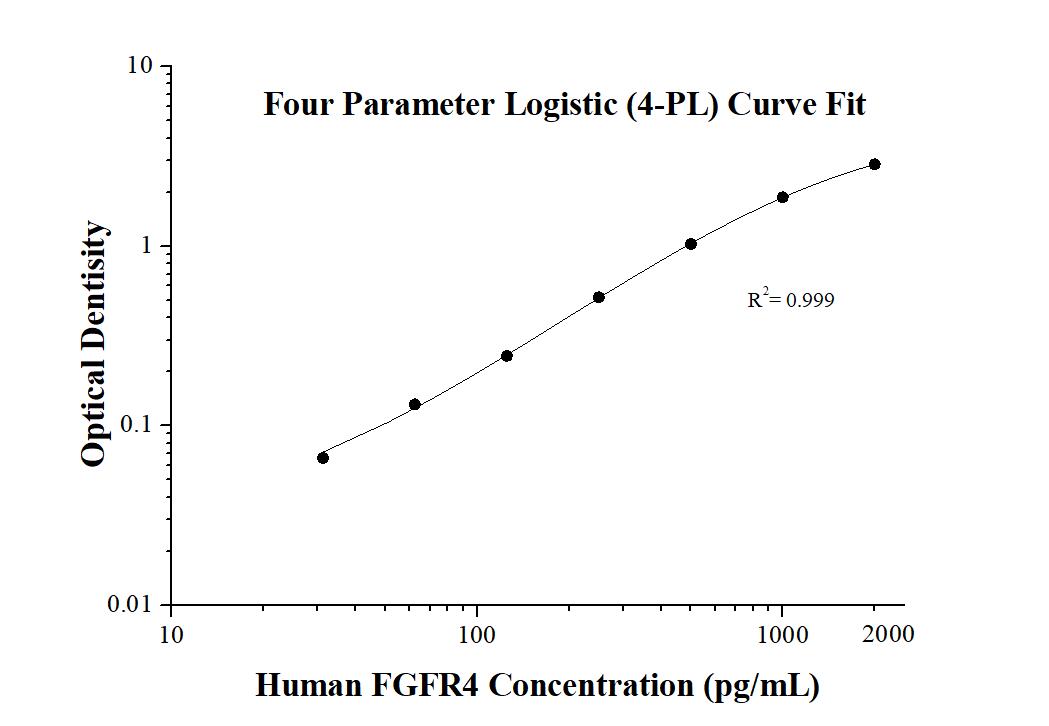Human FGFR4 ELISA Kit
Sensitivity
5.7 pg/mL
Range
31.25-2000 pg/mL
Reactivity
Human
Cat no : KE00321
Synonyms
CD334, FGFR 4, FGFR4, JTK2, TKF
Validation Data Gallery
Product Information
KE00321 is a solid phase sandwich Enzyme Linked-Immuno-Sorbent Assay (Sandwich ELISA). The human FGFR4 ELISA kit is to be used to detect and quantify protein levels of endogenous human FGFR4. The assay recognizes human FGFR4. An antibody specific for human FGFR4 has been pre-coated onto the microwells. The human FGFR4 protein in samples is captured by the coated antibody after incubation. Following extensive washing, another horseradish peroxidase (HRP)-conjugated antibody specific for human FGFR4 is added to detect the captured human FGFR4 protein. For signal development, followed by Tetramethyl-benzidine (TMB) reagent. Solution containing sulfuric acid is used to stop color development and the color intensity which is proportional to the quantity of bound protein is measurable at 450 nm with the correction wavelength set at 630 nm.
| Product name | Human FGFR4 ELISA Kit |
| Tests | 1 X 96 well plate |
| Sample type | Serum, Plasma, Cell culture supernatant |
| Assay type | Sandwich |
| Sensitivity | 5.7 pg/mL |
| Range | 31.25-2000 pg/mL |
| Reactivity | Human |
| Tested applications | Sandwich ELISA |
| Gene ID (NCBI) | 2264 |
Recovery
| Sample Type | Average | Range |
|---|---|---|
| Human plasma | 111% | 103%-117% |
| Cell culture supernatant | 108% | 87%-117% |
IntraAssay
| Sample | n | mean ( pg/mL) | SD | CV% |
|---|---|---|---|---|
| 1 | 20 | 1,123.7 | 45.5 | 4.0 |
| 2 | 20 | 285.5 | 10.1 | 3.5 |
| 3 | 20 | 71.0 | 3.6 | 5.1 |
InterAssay
| Sample | n | mean ( pg/mL) | SD | CV% |
|---|---|---|---|---|
| 1 | 24 | 1,158.0 | 45.1 | 3.9 |
| 2 | 24 | 285.3 | 11.2 | 3.9 |
| 3 | 24 | 72.5 | 5.7 | 7.8 |
Background Information
Fibroblast growth factor receptor 4 (FGFR4) is a member of a highly conserved tyrosine kinase family, along with FGFR1-3. This family consists of an intracellular tyrosine kinase domain, a single transmembrane domain, and extracellular ligand binding domains. FGFR4 is the predominant FGFR isoform present in human hepatocytes. FGFR4 has been proposed to play a role in the observed induction of hepatocyte proliferation and carcinogenesis by FGF19; however, contradicting evidence proposing a protective role for FGFR4 in suppressing hepatoma progression has also been proposed. While the role of FGFR4 in cancer remains to be fully elucidated, several findings suggest that this receptor may be an important player in Hepatocellular carcinoma (HCC) development and/or progression.
Properties
| Storage Instructions | All the reagents are stored at 2-8℃ for 6 months or -20℃ for 12 months. Refer to the protocol for further storage instructions. |
| Synonyms | CD334, FGFR 4, FGFR4, JTK2, TKF |

